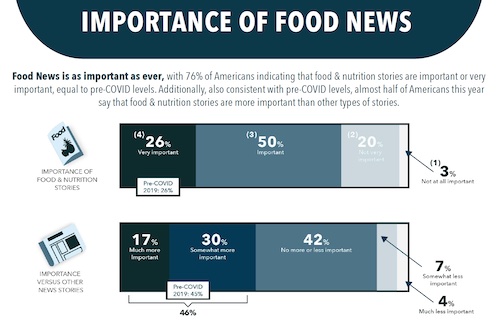 |
The influence of food-related news on consumers is on the rise in a COVID-impacted marketplace, according to a new study from Hunter.
Close to two-thirds (62 percent) of the 1,002 Americans that the agency surveyed between Oct. 15 and 21 of this year said that their opinions had been at least somewhat changed by media coverage of issues surrounding food. That’s up from the 58 percent who said that in the previous edition of Hunter’s Food News Study, which was conducted in 2019.
While consumers haven’t cut back on the amount of food news they get, they are going to fewer sources to get that information, the study says. For example, while 90 percent of the survey respondents said they had searched for recipes in both 2021 and 2019, the average number of sources they used dropped from 3.9 to 3.4. Similar trends can also be seen for general food news and news about nutrition.
Top platforms for food news include websites (#1 for those searching out recipes or nutrition info), social media (#2 for both of those groups and #3 for general food-news consumers), television (#1 for general consumers) and YouTube.
 |
When it comes to what topics are attracting the attention of consumers, COVID-related concerns come out on top. Half (50 percent) of those surveyed said they had seen coverage of mask mandates in restaurants, followed closely (45 percent) by coverage of the labor shortages that restaurants are facing.
Other topics registering high on consumers’ radar are inflation and higher food prices (39 percent), the Tyson chicken recall this past July (36 percent) and recipes that use air fryers (25 percent).
Part of the robust interest in food-related issues may stem from the fact that, according to the study, more Americans think of themselves as “foodies” than ever. The number of respondents who call themselves “creative cooks” rose from 20 percent in 2019 to 25 percent in 2021. Perhaps related to this trend is a lessened interest in “convenience-first” food products, dropping from 18 percent to 14 percent.
In addition, 43 percent of respondents say they are cooking at home more than they did two years ago, with only six percent saying they were cooking less of their meals themselves.
“The pandemic is reshaping consumers’ priorities with regard to food,” said Hunter chief insights and strategy officer Heddy DeMaria. “A greater portion of Americans consider food quality and discovery the most important factors defining their relationship with food. These are fundamental changes we expect to continue long after the pandemic ends.”
Hunter's study was conducted in partnership with Libran Research.
Stagwell owns Hunter.


 What the biggest meal of the day can teach us about serving up effective nutrition communications campaigns.
What the biggest meal of the day can teach us about serving up effective nutrition communications campaigns. Tips to refine and amplify your CPG brand strategy to win in 2024 and beyond.
Tips to refine and amplify your CPG brand strategy to win in 2024 and beyond. Strategic communications strategies for success in the growing “food is medicine” movement.
Strategic communications strategies for success in the growing “food is medicine” movement. How brands can authentically communicate sustainability issues and create a brand experience that’s compatible with consumers’ values.
How brands can authentically communicate sustainability issues and create a brand experience that’s compatible with consumers’ values. Communicating the effects that climate change and a growing world population have on our food system—and why change is needed.
Communicating the effects that climate change and a growing world population have on our food system—and why change is needed.


 Have a comment? Send it to
Have a comment? Send it to 
No comments have been submitted for this story yet.